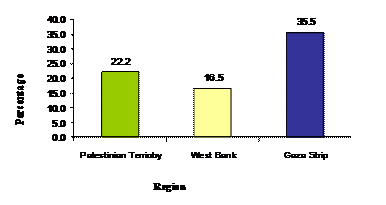Palestinian Central Bureau of Statistics (PCBS)
On the Eve of World Elderly Day 01/10/2012
The Palestinian Central Bureau of Statistics presents this release about the situation of the elderly (60 years and over) in the occasion of the international elderly day October 1st.
Elderly People in the Palestinian Territory represent 4.4% of the total population in mid 2012
The Palestinian Territory witnesses improvement in life expectancy since the beginning of the last two decades. Life expectancy has increased about 5-7 years during the last two decades. In particular life expectancy increased for both males and females from 67.0 years in 1992 to 71.3years for males and 74.1 years for females in mid of the year 2012. The life expectancy is expected to increase during the coming years to reach 72.0 years for males and 75.0 years for females in the year 2015. The increase of life expectancy rate at birth resulted in the increase of the elderly number in the Palestinian Territory which requires studying and researching the elderly situation in the Palestinian Territory.
Unchanging percentage of the elderly in the Palestinian Territory during the coming years
The Palestinian society is considered a young society where the percentage of youth is about half of the society and the percentage of the elderly is relatively small. In mid of the year 2012, the percentage of the elderly (aged 60 and over) reached 4.4% of the population in the Palestinian Territory (4.8% in West Bank and 3.7% in Gaza strip). Even though, the percentage of the elderly will be increasing during the coming years in the Palestinian Territory, their percentage will stay relatively low not exceeding 4.5% during the upcoming 10 years. The elderly percentage may start increasing after year 2020.
Increase of females percentage against males percentage
The percentage of males (aged 60 and over) in the Palestinian Territory reached about 3.9% in 2012 against 4.9% for females (80.5 males against 100 females).
One household out of six households is headed by an elderly person
Data of 2010 indicates that the percentage of the extended families in the Palestinian Territory reached 12% (10.6% in West Bank and 16.3% in Gaza Strip). The percentage of households headed by an elderly person in the 2nd quarter of 2012 reached 15.9% in the Palestinian Territory (17.2% in West Bank and 13.5% in Gaza Strip). The data indicates that the average size of the households headed by an elderly person is relatively small reached 3.7 individuals against 6.1 for the households not presided over headed by an elderly person in the 2nd quarter of 2012, (3.5 individuals for the household in West Bank and 4.2 individuals for the household in Gaza Strip).
Average of household size headed by an elderly person in the Palestinian Territory by region, the 2nd quarter of the year 2012

About Half of elderly females are widows
About 91.9% of the elderly males in the Palestinian Territory are married against 45.2% of the elderly married females. The percentage of the elderly widowed males reached 6.8% against 46.1% for females in the 2nd quarter of the year 2012.
More than half of the working elderly are self-employed
The percentage of the elderly contribution to the labor force reached about 15% of the total labor force in the Palestinian Territory during the 2nd quarter of the year 2012. There are differences in the working status of the elderly in terms of area and sex. The percentage of the elderly contribution to the labor force in West Bank reached 18.2%; while in Gaza strip reached 8.3%. The percentage of the unemployed elderly in the West Bank reached 3.9% against 8.9% in Gaza strip. The percentage of the unemployed elderly males reached 5.9% against 0.7% of the unemployed elderly females. The data indicates that 59.9% of the working elderly are self-employed; while 13.4% are paid employees.
High percentage of illiterate elderly in 2011
The data indicates that there is high percentage of illiterate elderly in 2011. The percentage of the elderly who have not completed any educational stage reached 59.1% (38.2% males and 75.6% females), and the percentage of illiteracy rate for elderly was 42.0% of the total elderly persons. They represent about 66.0% of the illiterate persons in the Palestinian Territory. The percentage of the elderly who obtained diploma and higher is 9.7% in the Palestinian Territory. Education data 2011 indicates that there is an obvious difference between males and females in receiving education where the percentage of the elderly males who have obtained diploma and higher reached 16.7% against 4.0% for elderly females knowing that the illiteracy percentage of the individuals aged 15 and over does not exceed 4.7% (2.1% males against 7.4% females). The percentage of the individuals (aged 15 and over) who obtained diploma and higher reached 16.1% of the population (aged 15 and over) (16.9% males and 15.1% females) in the Palestinian Territory.
Prevalence of chronic diseases among the elderly
The Palestinian Family Survey 2010 data indicates that 70.7% of the elderly aged 60 and over are infected with at least one chronic disease (71.6% in West Bank and 68.7% in Gaza strip) in the Palestinian Territory. The data indicated that females are more infected with 75.4% against 64.7% males.
Percentage of the Prevalence of chronic diseases among the elderly by region, 2010

Elderly males smoke 11 times more than elderly females
2010 data indicated that 15% of the total elderly in the Palestinian Territory smoke (30.9% males and 2.7% females) (18.0% in West Bank and 9.0% in Gaza Strip).
More than one-third of the elderly evaluate their health status less than good-bad
2010 data indicated that 38.4% of the elderly in the Palestinian Territory evaluate their health status less than good to bad (39.7% in West Bank and 35.4% in Gaza Strip).
More than one fifth of the elderly are living in poor families in 2011
The data indicated that the percentage of the elderly living in poor families in 2011 reached 22.2% which is equivalent to 4.7% of the total number of poor people in the Palestinian Territory, knowing that the percentage of the elderly does not exceed 4.4% of the total population in Palestine . The percentage of the elderly living in poor families in West Bank reached 16.5% against 35.5% in Gaza Strip.
The percentage of the elderly living in poor families by region, 2011

Half of the elderly do not read newspapers and magazines
2010 data indicated that 47.1% of the elderly in the Palestinian Territory do not read newspapers or magazines at all (41.1% in West Bank and 60.1% in Gaza Strip). 65.4% of the elderly watch daily television and 27.8% listen daily to the radio.
 عربي
عربي